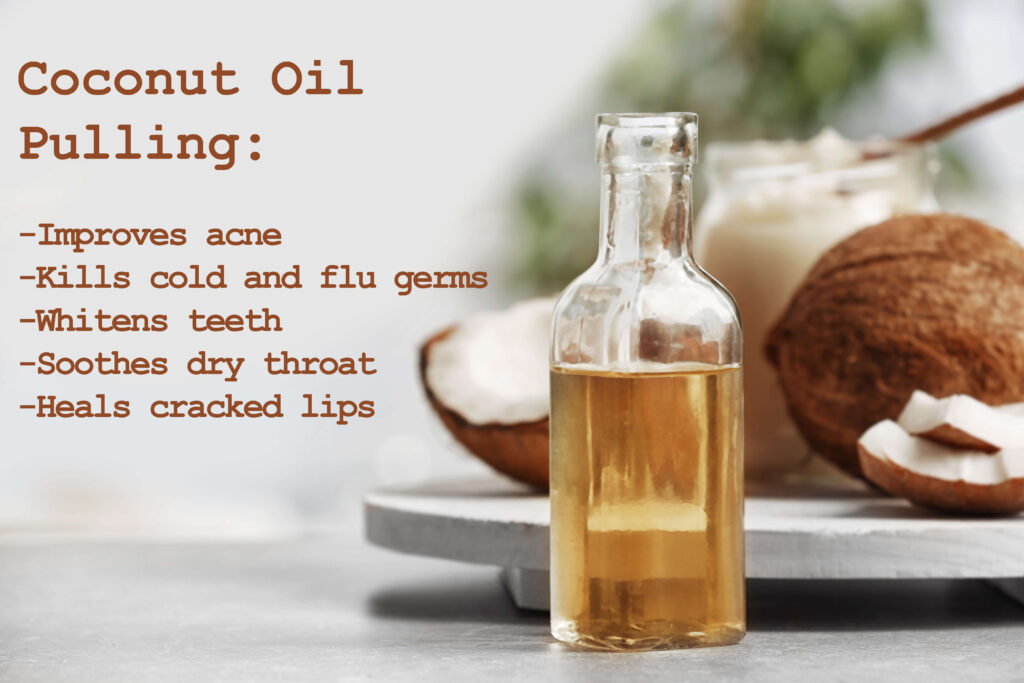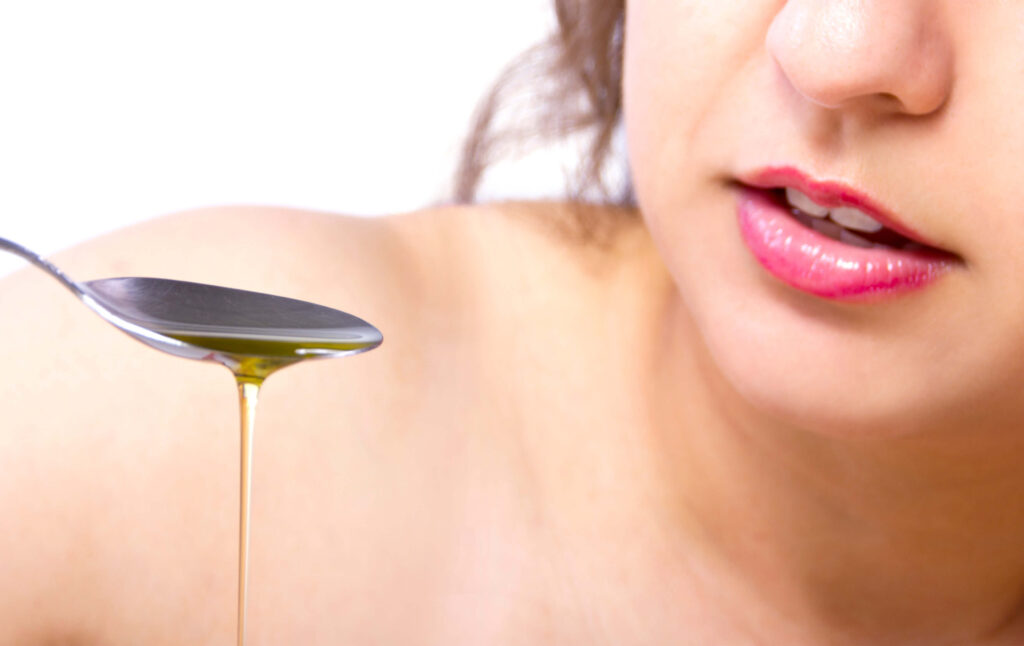In the teachings of Ayurveda, there are such concepts as Kavala and Gundusha. In simple terms, it is rinsing the teeth and mouth with oil. For many people, such actions are not quite clear and it is necessary to clarify what they are and why such procedures are carried out, as well as to determine whether they are useful or not.

What Is Oil Pulling?
An oil rinse is a special process in which oil is used to rinse the ayurvedic medicine for teeth and gums. This process can be of two types: Kavala and Gundusha. In Kavala, the procedure is aimed at cleansing the mouth. To do this, the oil is held in the mouth and rinsed by drawing in through the teeth and around the gums.
In Gundush, the mouth is filled with oil and held. These methods help ensure a clean mouth and strengthen the muscles of the mouth and jaw. Therefore, they have the effect of improving overall health and well-being.
How Does Oil Pulling Work?
The Ayurveda is considered a major diagnostic tool where oral health is directly related to a person’s overall health. Oil pulling for cavities is even a necessity because there are many different bacteria in the mouth and the oral cavity is adjacent to the esophagus, ear cavities, nasopharynx, etc. The occurrence of harmful bacteria in the mouth can have detrimental effects on the entire body.
Because bacteria are attracted to the lipid structure of the oil, they can be pulled out of the mouth with the oil’s fatty molecules. As a result, they are “flushed out by the oil” and the person feels better. This method has been proven over the years and improves oral hygiene. It is approved not only by Ayurveda teachings but also by dentists.

Oil Pulling Benefits
There are quite a few benefits of oil pulling. They include:
- whiter cleaner teeth;
- stronger gums, jaw, and teeth;
- cavity and gingivitis prevention;
- fresher breath;
- improved sleep quality;
- headache and migraine relief.
And of course the whole body detox. But before using it, you should be familiar with the instructions for oil pulling.
Possible Side Effect of Oil Pulling
Scientists have not yet identified any known side effects of Oil Pulling. However, some may experience pain in the jaw or a headache with sudden movements. If oil is swallowed, diarrhea or upset stomach may occur.
This procedure is not a substitute for brushing or flossing. This method helps as a supplement to the usual and recommended variations of dental care by dentists. But there is never much care, so Oil Pulling can improve the effect of brushing.
Detox Symptoms from Oil Pulling
In the teachings of Ayurveda, rinsing the mouth with oil will help level out the onset of 30 different diseases. Even representatives of traditional medicine claim that this procedure helps activate salivary enzymes to absorb toxins.
In this case, the oil helps to detoxify the chemical and bacterial toxins from the blood. It can be used to fight sore mouths, sores, tooth decay, and gum damage. Even swelling goes away thanks to Oil Pulling.
How to Do Oil Pulling?
For this procedure it is necessary:
- place a tablespoon of oil in your mouth;
- rinse your mouth by actively pressing on your teeth and gums, it is important to make sure that the oil gets into all corners of the mouth because many microorganisms live in the oral cavity;
- repeat the procedure without spitting the oil for 5 to 20 minutes in the morning;
- spit the oil out into the trash immediately, do not spit it out into the sink (in this case, there is a risk of clogging the drain);
- never swallow the oil.
To restore your teeth faster, the Ayurvedic teachings suggest this procedure before every meal.
For convenience, all the steps of how to properly perform an oil mouthwash are illustrated below. Each of the steps is detailed so that those who are new to the practice will not have any additional questions:
- Prepare a tablespoon of coconut oil once you are in the bathroom first thing in the morning.
- Swish the contents of the tablespoon in your mouth for around 15 minutes.
Once done, spit everything out and rinse your mouth with warm water.

Best Oils for Oil Pulling
A variety of cold-pressed oils are suitable for this procedure. The most commonly used oils for pulling are coconut oil, sesame oil, and ghee oil. Each of these can have a different effect on improving a person’s oral cavity.
Coconut Oil for Oil Pulling
Coconut oil is considered to be the most effective oil for mouthwash procedures. Its composition is very viscous and can draw unwanted bacteria out of the human body as much as possible. That is why it is most often recommended for use in Ayurvedic teachings.
Through its use, you can successfully fight not only bacteria but also plaque. Also gargling with coconut oil helps to get rid of bad breath. But before using it, you must be sure that there is no danger of coconut oil pulling for you. That you have no individual intolerance, etc.
Sesame Oil for Oil Pulling
Sesame oil can have an additional effect. Because it contains chlorosammon, rinsing the mouth with this type of oil helps to counteract antifungal growths. Sesame oil also has a lot of fatty acids that successfully fight bacteria.
In addition, this type of oil can help in detoxification of the body. Because of this, sesame oil is considered the best alternative to coconut oil.
Ghee Oil Pulling
Using ghee oil for this procedure is also considered a good option for dental care. This method helps to clean the mouth as well as previous options. It removes plaque and calculus from the teeth. This is extremely important because a toothbrush or floss will not do the job. In Ayurvedic teachings, ghee is referred to as an elixir. Its main difference is the composition. The fact is that ghee can be ingested without any deterioration of one’s health. This distinguishes it from other types of oil. However, you should not forget that when Oil Pulling you must spit out the oil because it is saturated with harmful bacteria.
Sunflower Oil for Oil Pulling
Sunflower oil for Oil Pulling is considered a relatively good option. It’s great for dealing with tough plaque and tartar buildup. That said, not all oils can help remove thick plaque and large tartar. But to achieve a similar effect, you need to rinse your mouth with oil properly.
Palm Oil for Oil Pulling
Palm oil also has certain advantages. It is used less often than coconut or sesame oil for mouthwash, but it is also widely used. It can help in treating gums and in preventing tooth decay. But like other types of oil, palm oil should be used carefully and never swallowed.

TOP 7 Questions about Oil Pulling
What is Oil Pulling for?
Oil Pulling is a special oral care treatment using a variety of oils. It can pull harmful bacteria from the body and help clean your mouth, teeth, and gums.
What Oil Can Be Used for Oil Pulling?
A variety of unrefined, cold-pressed oils can be used for this procedure.
Is Oil Pulling Effective?
This procedure is effective and helps to improve the digestive tract and minimize damage from harmful bacteria.
Can You Use Olive Oil for Oil Pulling?
Yes, you can use cold-pressed olive oil.
Do You Oil Pull Before or After Brushing?
It is recommended to oil pulling after brushing teeth. After teeth pulling oil, you shouldn’t brush your teeth, otherwise, you won’t get any effect from the procedure.
Does Oil Pulling Help Gums?
Yes, there are a lot of health benefits of oil pulling. Oil Pulling will help improve the overall health of both your teeth and gums.
How Long to Do Oil Pulling?
For the best effect, the procedure should be done regularly. Perfect oil pulling time is before meals, three times a day for 28 days.

